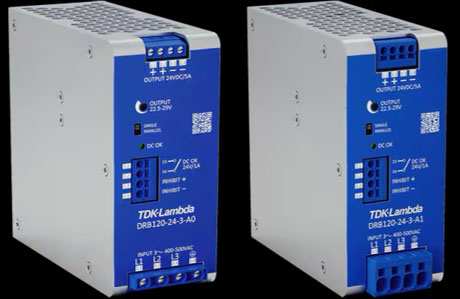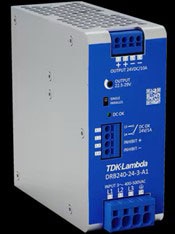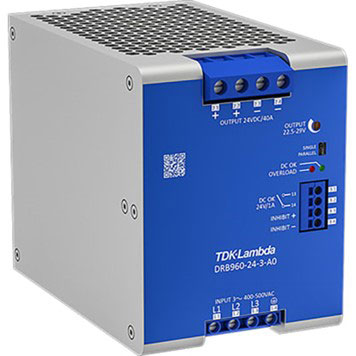TDK-Lambda 3-Phase Power Supplies Provide Many Options for DIN Rail Applications
DIN rail power supplies provide a compact, reliable, and easy-to-install solution for powering various devices and systems in industrial, automation, and building applications. Selecting the right DIN rail power supply for a specific application should not be taken lightly, as there are many factors to consider, ranging from input voltage and output power to efficiency and wiring connectivity options. TDK-Lambda offers a series of mid-range, 3-phase DIN rail AC-DC power supplies that can lower operating costs and improve thermal performance across a broad range of applications.
Worldwide, DIN rail power supplies, including 1, 2, and 3-phase units, comprised $2.10 billion in 2023 to $2.18 billion in 2024, with a projected compound annual growth rate of 4.27% through the end of the decade.i
Mounted on industry-standard DIN rails, these units power a diverse range of control panels and electrical cabinets essential for equipment and control systems in manufacturing, commercial buildings, industrial automation, process control, transport, and other electrical applications. They help overcome the complexity of configuring and wiring electrical control systems.
TDK-Lambda's DRB product family is available in four power levels, from 120 W to 960 W, with output voltages ranging from 12 V to 72 V. Balancing functionality and price, power supply units with the same voltage and current can be connected in parallel to provide greater power or for redundancy, and are packaged in compact cases to save valuable real estate on a DIN rail.
These power supplies generate less internal heat, resulting in cooler electrolytic capacitors that the company says typically have a life span up to 10 years or longer. Operating efficiencies, thermal design, and redundant overvoltage protection measures provide maximum system up-time. With high efficiency and low stand-by losses, the devices can help product designers achieve an eco-friendly energy footprint.
They are available with traditional screw terminals, or push-in connectors that can reduce assembly time by half. Push-in connectors are more readily suited to robotic or automated assembly, and tool-free wire insertion and easy removal can simplify maintenance and upgrades in the field. Crimped ferrules are utilized for wire termination, although in the U.S., stranded wires may also be used for reduced contact resistance.
Other key benefits of utilizing these power units include:
- Improved thermal performance
- Reduced electrical noise
- High efficiency up to 96.3%
- +50% boost power capability up to 600 seconds
- Support for capacitive and inductive loading
- Low energy inrush current to avoid nuisance tripping of circuit breakers
- Low standby power consumption of < 2.3 W when using the remote on-off function
DRB-3 models with the same voltage and current can be connected in parallel, using a front-panel slide switch to configure them. With load current shared between power supplies, the thermal stress on electrolytic capacitors is reduced, enhancing field longevity. The company offers 20 models spanning the four series in its DRB-3 lineup.
Energy-saving efficiencies
The DRB120-3 series combines low cost, reliability, and compact dimensions with energy-saving efficiencies up to 92%. They offer a choice of 12 V and 24 V outputs and provide a maximum power of 120 W, with a maximum peak power of 144 W for 2 seconds. The DRB120-24-3-A0 (Figure 1, left) is a 24 V model with conventional screw terminal connectors, while the DRB120-24-3-A1 (Figure 1, right) also delivers 24 V and has push-in connectors.
 Figure 1: The 24 V DRB120-24-3 versions with screw connectors (left) and push-in connectors (right). (Image source: TDK-Lambda)
Figure 1: The 24 V DRB120-24-3 versions with screw connectors (left) and push-in connectors (right). (Image source: TDK-Lambda)
The DRB240-3 series are 240 W models with a choice of 24 V and 48 V outputs that have a maximum peak power of 288 W for 300 seconds. Versions are available with push-in terminal connections, as with the DRB240-24-3-A1 (Figure 2). Both the DRB120-3 and DRB240-3 have the same case dimensions of 5.44" L x 5.08" W x 2.17" H (138.2 mm x 129.0 mm x 55.1 mm).
 Figure 2: The push-in terminal connector version of a 24 V DRB240-24-3 power supply. (Image source: TDK-Lambda)
Figure 2: The push-in terminal connector version of a 24 V DRB240-24-3 power supply. (Image source: TDK-Lambda)
The DRB480-3 models provide maximum power of 480 W, a maximum peak power of 720 W, and output options of 48 V and 72 V. Case dimensions for these models are 5.86" L x 2.56" W x 5.08" H (148.8 mm x 65.1 mm x 129.0 mm).
The DRB960-3 series (an example in Figure 3) represents the highest power models. They offer continuous operation at 960 W and can deliver a boost of 1440 W for up to seven seconds. This series provides a choice of 24 V, 48 V, and 72 V outputs, with case dimensions of 6.27" L x 3.94" W x 5.08" H (159.1 mm x 100.0 mm x 129.0 mm).
 Figure 3: TDK-Lambda's DRB960-24-3-A0 is a 24 V, 960 W power supply with screw connections. (Image source: TDK-Lambda)
Figure 3: TDK-Lambda's DRB960-24-3-A0 is a 24 V, 960 W power supply with screw connections. (Image source: TDK-Lambda)
Conclusion
Mid-range 3-phase input DIN rail power supplies are in constant demand for industrial and process control applications. TDK-Lambda's DRB120-3, DRB240-3, DRB480-3, and DRB960-3 series provide options for four power levels, four output levels, and push-in or conventional screw terminal connections to meet the needs of varied applications.
1 https://www.researchandmarkets.com/report/din-rail-power-supply

Have questions or comments? Continue the conversation on TechForum, DigiKey's online community and technical resource.
Visit TechForum









